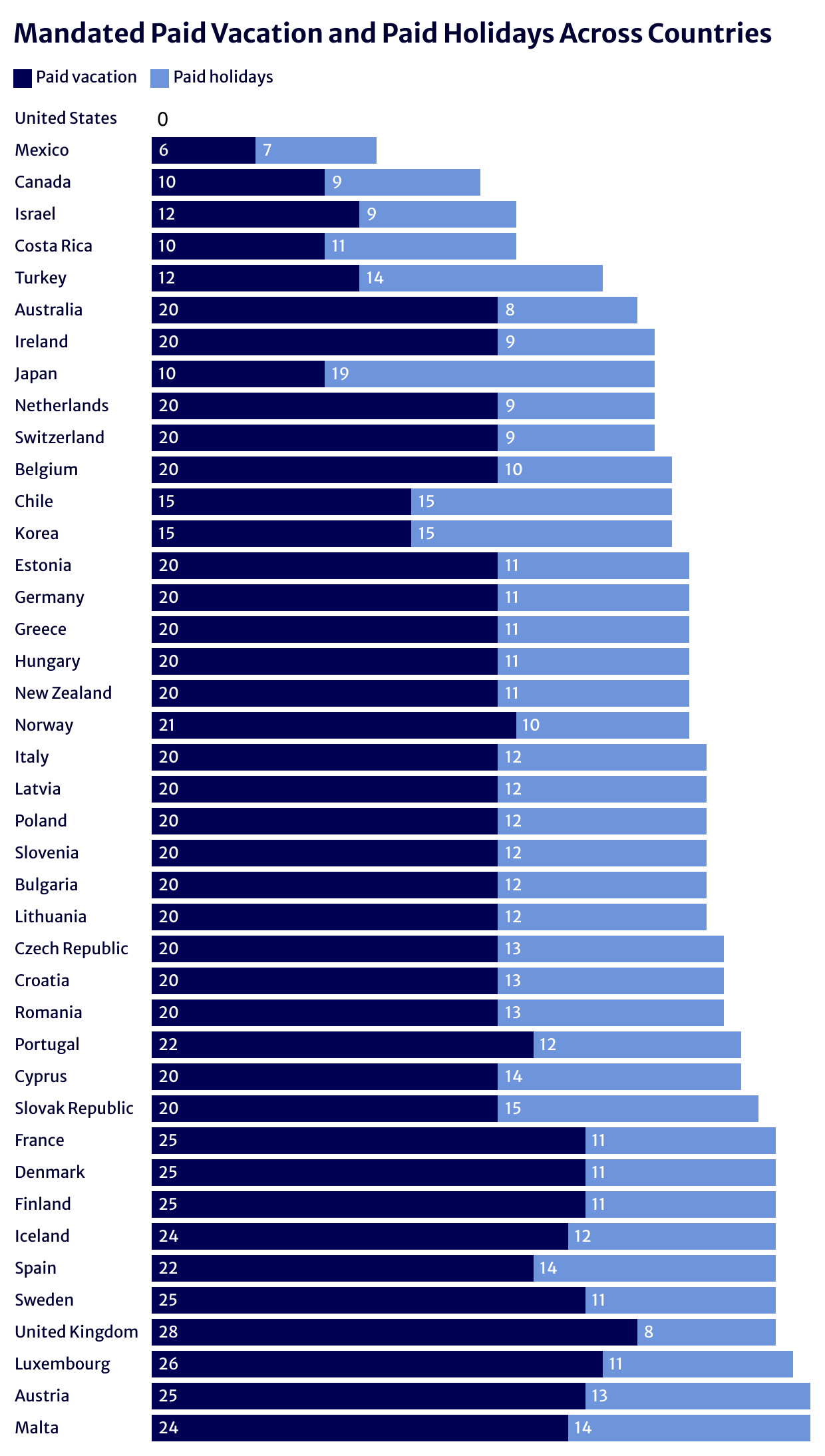December 13, 2023
The holidays are coming up and many Americans are looking forward to some time off. Unfortunately, some workers may not be able to take vacation, while others may take time off and receive no pay. The United States stands as an outlier among rich countries and even many much poorer countries when it comes to mandated paid time off for holidays or vacations — creating a financial burden for many workers who do take time off.

Note: Worker benefits generally reflect those for full-time, full-year private sector employees, working a five-day week, who have been working for their current employer for one year. Data as of January 2020.
Source: OECD Family Database, Table PF2.3.A.
The figure shows data collected from the Organisation for Economic Co-operation and Development (OECD) on the number of days of paid vacation and paid holidays workers are entitled to across 42 countries.1 While the US recognizes 12 holidays, mandated pay for those holidays only applies to the federal government workforce. Universal leave policy does not exist in the US, even as there are some states and a few cities that have mandated policies for workers to accrue hours of paid time off for paid sick leave or general leave.2
For the majority of workers in the US, paid time off for holidays and vacations (and any other paid leave) is entirely at the discretion of their employer. This explains why there is such a wide variation in access to paid leave across the US workforce. Data from the Bureau of Labor Statistics (BLS) National Compensation Survey reports workers’ access rates to an array of employee benefits — including instances of both paid vacation and holiday leave. These data show access to both paid vacation and holiday leave varies greatly across occupations, industries, full- and part-time status, union representation, and wage levels.
Three out of four workers (75 percent), on average, have access to both paid vacation and paid holiday leave, where access is defined as a worker having at least one day each of paid vacation and paid holiday leave per year. Of those with paid leave for vacations and holidays, the number of days available varies greatly across the workforce. For instance, 44 percent of US workers with at least 20 years of service to a place of employment have fewer than 20 days of vacation.
Access to both paid vacation and holiday leave varies significantly depending on occupation and industry sector, as well as employment circumstances. Just 46 percent of those in service occupations have access compared to 96 percent of those in management, business, and financial occupations — exhibiting a remarkable 50-percentage point difference between these two groups of workers.
There is also a staggering 55 percentage-point gap between those who work full-time (88 percent) and those who work part-time (33 percent). Across wage categories, 93 percent of those in the highest paid 10 percent of the workforce receive access, a rate that falls to just 48 percent for the lowest paid 10 percent. As is typical, being a unionized worker helps. Eighty-eight percent of unionized workers have access, compared to only 73 percent for their non-unionized counterparts. Establishment size matters, too. The smallest firms (employing one to 49 workers) have a 66 percent rate of access, compared to an 89 percent rate for the largest firms (500 or more workers).
These vastly different rates of access to paid holiday and vacation leave are why it is imperative to establish a legal baseline of universally-mandated access to ample paid leave.
Paid leave for holidays and vacation are essential components of a good life-work balance. There are benefits to both workers and their employers of paid time off. The benefits of paid leave have been shown to be associated with reduced depression diagnosis and improved employee morale, hiring, and retention. Our peer countries and many other countries much poorer than we are ensure that their workers have mandated time off that is paid — the US could certainly do much more.
- Note this reflects private sector-full time employees who have been with their employer for a year or longer.
- See: Paid sick leave laws by state






